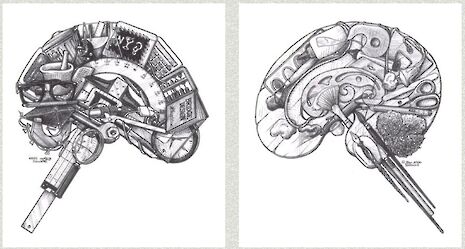Brain structures cannot explain STEM gender disparity
More care is needed when using sex-differences in brain structure alone to explain gender imbalance in STEM. Bethan Clark responds to the recent article by Shadab Ahmed

Explanations for gender inequality can be a touchy subject, and rightly so. Approaches to solving issues such as the STEM gender disparity often link back to the question of nature versus nurture, with neurology used to suggest innate differences are a cause. However, it is important to take such interpretations of neurological data with a pinch of salt: it is often no better evidence for innate differences than sources such as behaviour.
The problem stems from the property of the brain called plasticity: the ability to change the structure of the brain, from the level of neurons, in response to environmental stimuli. Plasticity is vital because in its absence it would be impossible to learn anything. It’s the reason that describing a brain as ‘hardwired’ is misleading, as it implies true, fixed differences. The process of accumulating knowledge or habits has to have a physical basis; this physical basis is the rewiring of the brain’s connections.
For example, repeatedly using a pathway causes it to strengthen over time; this is visible as larger structures in brain scans. A good example is the case of London taxi drivers, whose hippocampi were measured to be larger than bus drivers (who matched the taxi drivers for factors such as stress but follow set routes). This makes sense, because the hippocampus is involved in spatial memory, which taxi drivers regularly make use of. Importantly, due to the constraints of a fused cranium, the overall brain size doesn’t have much room to change. Instead, other regions of the brain shrink as the used regions grow. This is the flip-side to plasticity: if there is no need to use a pathway it weakens, with material and energy re-purposed elsewhere in the brain where it’s more necessary and relevant.
What does this all have to do with sex differences? It’s well documented that from a young age boys and girls are subject to different experiences, from the reinforcement of different behaviours to the gendered marketing of toys. These experiences teach children to behave differently according to their gender, a recognised reason not to use behaviour as evidence for innate sex differences. However, in the application of neurological research, it can be forgotten that this learning process has a physical basis – changes in the brain due to plasticity. Therefore although structural differences found are often reflected by behavioural differences, they are not necessarily the cause for behavioural differences.
An example of a plastic structure is the corpus callosum, illustrated by studies investigating the effect of musical training. This connective piece of brain tissue was found to be larger in musicians than non-musicians, and larger increases were found in those who began training before the age of seven, suggesting a sensitive period when plasticity is most effective. The corpus callosum is sometimes claimed to be larger in females to explain differences in skills such as language processing, but this evidence of plasticity means any difference may only be an effect of social experiences. That is, being socialised to use this bundle of fibres more could explain the size increase, instead of the other way round. The point is we don’t know. Cause and effect is difficult to disentangle so we currently can’t draw conclusions either way. In fact, sex differences in corpus callosum size may not even exist: a meta-analysis of all studies found no significant difference.
On the other hand, there are some types of neurobiological sex differences that are less dependent on environmental effects. For example, it was found that children who matured early, regardless of sex, have higher verbal skills and later developed spatial skills versus later maturers. Coupled with the earlier average maturation of girls relative to boys, average sex differences in these skills might be a by-product of maturation times. This effect may be biasing girls and boys against different skill-requiring subjects, possibly channeling girls away from science before they have the chance to explore their interests. If this were the case, a further modified curriculum to accommodate this difference in maturation might change these early-formed effects and encourage a wider range of career choices.
Neurobiology is too often over-interpreted to explain all observed sex differences. The truth is more complicated than that, because, like most ‘this or that’ possibilities in biology, nature versus nurture is likely a complex mix of both. Plus, of course, all these analyses investigate average differences between sexes, which are cast into doubt in the cases where variation between individuals is greater. At this stage in our understanding of the neurobiology of sex differences, it is just not possible to put outcomes in boxes and mark each one with its own neurological cause.
We should neither dismiss neurological discoveries to accommodate opinions or ideologies, nor use them to promote others. Instead we have to recognise that neurology won’t provide us with clear-cut explanations: its application requires consideration of many other factors. It’s too easy to pounce on neurobiology as evidence for innate sex differences and infer explanations for issues such as the STEM disparity, but the truth is it’s just too complex for our current understanding to give a conclusive answer.
If you would like to respond to this article and write for us, please email in to science@varsity.co.uk
 News / Government announces £400m investment package for Cambridge25 October 2025
News / Government announces £400m investment package for Cambridge25 October 2025 Arts / Why is everybody naked?24 October 2025
Arts / Why is everybody naked?24 October 2025 News / Cambridge don appointed Reform adviser23 October 2025
News / Cambridge don appointed Reform adviser23 October 2025 News / Climate and pro-Palestine activists protest at engineering careers fair25 October 2025
News / Climate and pro-Palestine activists protest at engineering careers fair25 October 2025 Comment / On overcoming the freshers’ curse22 October 2025
Comment / On overcoming the freshers’ curse22 October 2025








